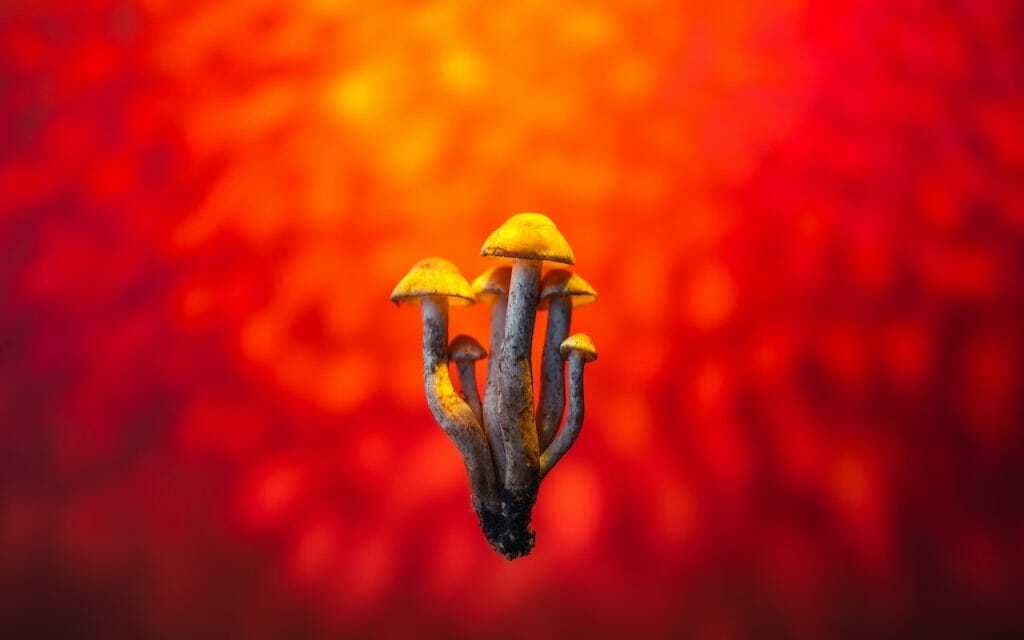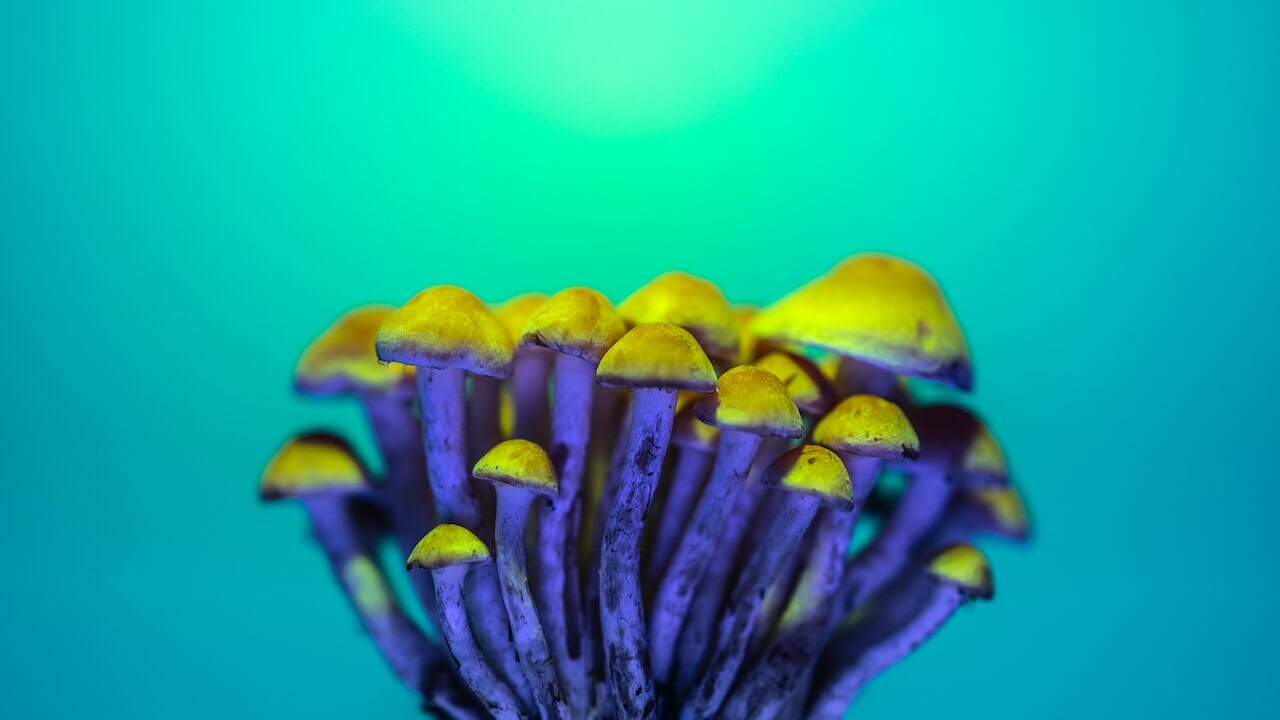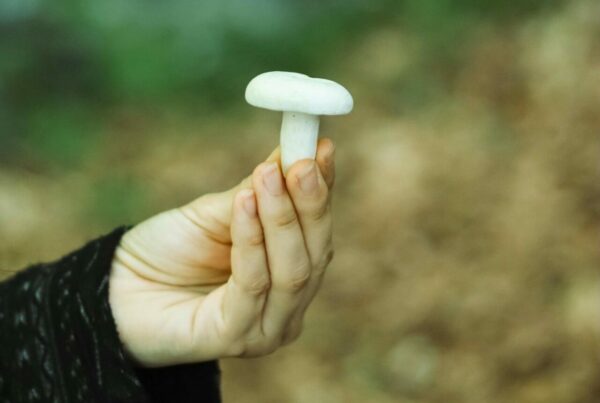Lysergic acid diethylamide (LSD) is a highly potent hallucinogen that has been thoroughly studied as a psychedelic substance. Initially known for recreational purposes, LSD is now seen as a psychoactive compound that could potentially benefit mental health. This shift in perception has led to a more in-depth exploration of the effects of LSD in more user-friendly formats, such as LSD edibles.
Key Takeaways:
- Derived from the ergot fungus, LSD is a powerful hallucinogen.
- LSD shares similarities with psilocybin and interacts with 5-HT2A receptors.
- Known effects of LSD include altered vision, mood changes, ego dissolution, and pseudo-hallucinations.

Demystifying LSD
As a remarkably potent hallucinogen, LSD can profoundly shift a person’s reality perception and greatly distort the senses. LSD originates from “ergot,” a fungus that grows on rye and similar grains.
At the molecular level, LSD belongs to the ergoline family and is a complex compound. It consists of a bicyclic hexahydroindole group and a bicyclic quinoline group (lysergic acid). The term ‘Lysergic Acid Diethylamide’ derives from the functional group attached to its core. LSD’s structure mirrors other ergoline alkaloids, such as ergotamine found in the ergot fungus Claviceps purpurea, and the neurotransmitter serotonin.
The Effects of LSD
Once consumed, LSD travels to the brain, sparking chemical reactions that can linger for several hours. LSD may induce the following temporary effects:
- Erratic mood changes
- Distortion of perception
- Feelings of dizziness
- A decrease in appetite
- Difficulty in movement control
The Advantages of LSD
What Are the Benefits of LSD Use?
LSD offers a range of benefits that heavily depend on the dosage consumed. Most studies highlight the benefits of consuming small amounts of this psychedelic substance. In the following sections, we explore the positive impacts of LSD use.
Pain Relief and Neurogenesis
Researchers at Maastricht University have discovered that a single microdose of LSD can induce pain-alleviating effects that persist for a minimum of five hours.
During a Cold Pressor Test, where participants immerse their hands in 3°C (37.4°F) water for as long as possible, individuals who took 20 mg of LSD were able to maintain their hand submerged 20% longer than those who didn’t. They also reported less pain and discomfort.
Furthermore, LSD can assist in the development and expansion of the brain’s 86 billion neurons. Moderate LSD doses, ranging from 5 to 20 ug, increase the blood plasma’s BDNF levels. This is crucial as mood disorders like depression, often associated with neuroplasticity problems, could be mitigated due to LSD’s positive influence on neuronal health.
Improvement of Mental Health
Dr. Robin Carhart-Harris of Imperial College London introduced the entropic brain hypothesis. According to this theory, mental health disorders originate from rigid thought processes, maintained by an overly active default mode network (DMN). Psychedelics like LSD have the potential to disrupt the DMN, increase brain entropy, and promote the disintegration of harmful neural pathways while fostering the creation of beneficial ones.
A study involving more than 1,000 microdosers reported decreased depression levels. Another extensive cross-sectional study showed a decline in negative moods and detrimental attitudes, coupled with enhanced open-mindedness and cognitive function.
Addiction Treatment
A meta-analysis of randomized-controlled clinical trials using LSD in psychiatry demonstrated its effectiveness in treating alcohol dependence. This conclusion is further corroborated by the positive results reported by numerous patients treated for alcoholism by Humphrey Osmond and at the Spring Grove Hospital Centre during the 1950s and 1960s.
Reducing Anxiety and Depression at Life’s End
Research conducted by Dr. Peter Gasser has shown that using LSD in psychotherapy can provide significant anxiety relief for terminally ill cancer patients grappling with end-of-life issues. Furthermore, patients reported an improvement in their overall subjective quality of life. Currently, a Phase 2 trial is underway to assess the potential benefits of LSD therapy for individuals suffering from depression.
Decoding LSD Edibles: An Overview of Their Composition and Manufacturing Process
LSD edibles are a category of food and drink products that include the hallucinogenic compound, LSD. They can come in a variety of forms, including chocolates, candies, baked goods, and even unique offerings like LSD mints.
The Ingredients
- LSD: This is the primary active ingredient that produces hallucinogenic effects. It is carefully measured and incorporated into the edible.
- Edible Base: The LSD is usually dissolved or mixed into a consumable base such as a gummy, candy, sugar cube, or other edible substances. These bases act as the delivery system for the hallucinogenic compound.
- Flavouring and Ingredients: Depending on the specific product, additional flavourings, sweeteners, and other ingredients may be added to enhance taste and texture. These can include natural or synthetic flavours, colours, and sugars, and can vary widely.
The Manufacturing Process:
- LSD Synthesis: The first step is the chemical production of LSD. This requires a deep understanding of organic chemistry, along with the necessary chemicals, equipment, and a laboratory environment.
- Liquid Formulation: Once the LSD is synthesized, it is typically transformed into a liquid state by dissolving it in a solvent. This solution becomes a concentrated form of LSD.
- Infusion: The liquid LSD is then incorporated into an edible medium such as gummy candies, sugar cubes, or blotter paper. The chosen medium absorbs the liquid, enabling the LSD to be consumed orally.
Understanding the Psychedelic Impacts of Psychoactive Compounds in LSD Edibles
LSD triggers intense visual experiences. Colours become intensely vibrant, objects might seem to be encircled by halos or rainbows, and shapes can transform. Regardless of whether the users’ eyes are open or closed, they may witness
LSD is a powerful tool for altering one’s perception of reality, allowing for a change in self-awareness and environment perception. It can elicit myriad psychological states. It can make thoughts seem crystal clear and meaningful, or they can be devoid of logical consistency. Users may also experience alterations in their perception of time, space, and bodily self-image. Boundaries between the self and the external world may appear fuzzy. Some users describe experiencing a fusion of senses, such as seeing sounds or hearing colours.
Suggested LSD Products
While there are plenty of LSD-infused edibles available, it’s imperative to buy from a trusted dispensary. You need to verify that the edibles contain LSD and are not mixed with other substances like PCP (embalming fluid), ecstasy, or ketamine.
Deadhead Chemist – LSD Infused Gummies
Deadhead Chemist offers LSD-infused edibles, each containing 100 micrograms (ug) of LSD, in a variety of flavours. Each package contains a single gummy, which has demonstrated potential in assisting individuals with conditions such as obsessive-compulsive disorder (OCD), post-traumatic stress disorder (PTSD), alcohol addiction, depression, and cluster headaches.
Deadhead Chemist – Mint Tea
Deadhead Chemist’s raspberry mint tea provides a tastier and more aromatic way to experience LSD’s effects. LSD and other psychedelic substances act like the serotonin neurotransmitter and increase the brain’s state of flow.
Earthly Delights – Candy Flips
Candy flipping, which became popular during the rave culture of the late 1980s, continues to be enjoyed by modern-day thrill-seekers and party-goers. Users often report intense feelings of love and unity, accompanied by captivating visual experiences such as intensified colours, transforming objects, and complex geometric patterns.
Concluding Remarks
Historically, LSD has been known to facilitate transformative experiences. As our scientific understanding of this substance has grown, so has its popularity, particularly with the advent of LSD-infused edibles. These appetizing concoctions have made it possible to experiment with LSD safely and pleasurably, through controlled doses.
Fungalfriend Canada, being Canada’s leading supplier of high-quality shrooms online, boasts a comprehensive selection of LSD-infused edibles and cannabis products. Feel free to peruse our offerings, add the items you prefer to your cart, and then sit back and relax as we handle the delivery process. Our range also includes a variety of psilocybin shrooms, edibles, beverages, and capsules, for your convenience. Make sure to check out our LSD delivery page for more details!
Frequently Asked Questions
What sets LSD apart from psilocybin?
| CHARACTERISTICS | LSD | PSILOCYBIN |
| Origin | Semi-synthetic chemical compound | Naturally occurring in fungi |
| Available Forms | Tabs, microdots, liquid, gummies, blotter paper | Dried mushrooms, capsules, teas, chocolates |
| Potency | Highly potent, microgram doses (ug) | Varies based on mushroom species and preparation |
| Onset and Duration | Quick onset (15-60 minutes), short duration (3-5 hours) | Gradual onset (30-60 minutes), moderate duration (4-6 hours) |
What precautions can one take to avoid adverse experiences with LSD?
- Choose Your Environment Wisely
- Set Your Mindset
- Start with a Small Dose
- Have a Trip Guide
- Create a Peaceful Atmosphere
- Practice Deep Breathing and Grounding Techniques
- Accept and Let Go
How long do the effects last?
The psychedelic effects of the substance begin to appear between 30 to 60 minutes post-consumption. Individuals with a heightened sensitivity to psychedelics may start to feel the effects In just a quarter of an hour, you will start to notice the effects. It will take around an hour for you to be sure that you are under the influence of acid. The zenith of your trip typically occurs approximately three hours into the experience. It’s normal for time to feel like it’s stretching out, and hallucinations can be common.
Hang in there, it’s not unusual to feel a sense of disconnection from reality during this phase. The peak phase tends to last between 3 and 5 hours, followed by another 3 to 5 hours of the offset phase.
How does LSD interact with the human body?
LSD’s primary interaction is with the brain’s serotonin system, where it binds to and stimulates the 5-HT2A receptor. This interaction initiates a chain of neurochemical and physiological responses. Several factors can influence the effects of LSD, which can be vastly different.
Are there other types of LSD besides edibles?
Yes, LSD comes in various forms. The four primary LSD products are blotter paper, liquid solutions, tablets or microdots, and gelatin sheets.
Further Reading:





